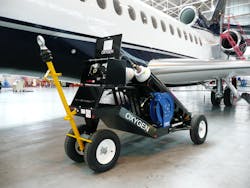Easy-Load Carts Lend a Hand
Even if a lone ground handler is in the process of charging an oxygen or nitrogen supply during a turnaround, efficiency and safety must remain a priority.
With that in mind, Newbow Aerospace developed its Easy-Load Nitrogen and Oxygen Service Carts, so a single operator can perform his or her duties effectively without jeopardizing safety on the ramp.
Newbow’s Easy-Load carts were designed and developed in 2012 and first launched in 2013. Since then, three variants of these carts have been created – two-bottle, three-bottle and four-bottle configurations. What’s more, the service carts offer a choice of three varying charging systems – dual use (low and high pressure), low pressure only or high pressure only.
“Initially, we were approached by a customer in UAE, asking if we offered a nitrogen service cart that was more user-friendly,” says Marc Green, sales director at Newbow Aerospace. “From that single request, we set about the necessary R&D, placed three prototype carts into varying environments and created a design that was unique to the industry.”
The carts come standard with a pivoting front axle, which offers articulation, company officials explain.
“This configuration gives the cart a high degree of stability in the event of high-speed cornering or traveling over rough terrain,” says Green. “In addition, the easy-load cylinder tray allows one person to safely load and off-load the required number of gas cylinders simultaneously.”
The one-person operation is achieved in a number of ways, Green explains.
The gas cylinder stowage tray pivot point and final resting angle of 30-degrees allow one-person to comfortably lower and lift the tray when loaded with two gas cylinders. Whereas the easy-load cylinder tray on the four-bottle cart is hydraulically operated with a hand pump.
“To comply with industry regulations, the hand pump fitted to the oxygen cart features a specialist inert, oxygen compliant hydraulic fluid,” Green adds.
Additional features include self-venting pressure setting regulators, secondary isolation valves, pressure relief valves and calibrated pressure gauges, which all form part of the charging system.
The Easy-Load service carts are suitable for any aircraft that requires nitrogen or oxygen gas in order to be deployed. Newbow Aerospace also manufacturers additional tooling that is compatible with the service carts and various aircraft applications.
Officials at Newbow point to the carts’ construction, which features laser-profiled sheet steel that is specially folded and welded together, as a feature that sets this product apart from others in the market.
“This design is far more complex than the common box section steel designed carts, but the end result offers a far more robust and long-lasting product,” Green explains, adding tests have shown the Easy-Load carts are capable of withstanding a load seven times greater than its intended use.
From a safety standpoint, the location of the low- and high-pressure outlet hoses was strategically selected.
“These hoses terminate from the rear of the charging cabinet and down into an open void before connecting to the auto-retracting hose reels,” Green says. “This design ensures the outlet hoses termination point from the charging panel is not in the vicinity of the operator when a live charging task is being undertaken.”
Both the nitrogen and oxygen carts feature excess pressure relief valves, self-venting regulators and anti-whip bottle connecting hoses.
The oxygen cart also provides static heat-soak gas inlet stems, ESD bonding and earth grounding to improve safety.
Further optional features include different pressure rated charging cabinets, gas booster systems, gas cylinder refill ports, various size towing eyes and forklift mounting plates. Company officials also expect additional improvements to be announced later this year.
Currently the carts, which have been designed and manufactured to comply with industry standards and received approval by BAE Systems, are being utilized in Europe, UAE, Asia, Australia and in the United States.
About the Author
Josh Smith
Editor
Josh Smith served as editor of Ground Support Worldwide as editor from 2016 through 2024. He oversaw production of the print magazine, created GSW's newsletters on a daily basis, and updated the latest news on AviationPros.com.

